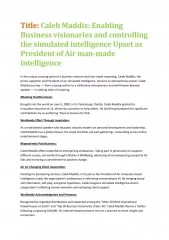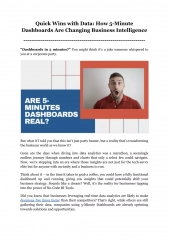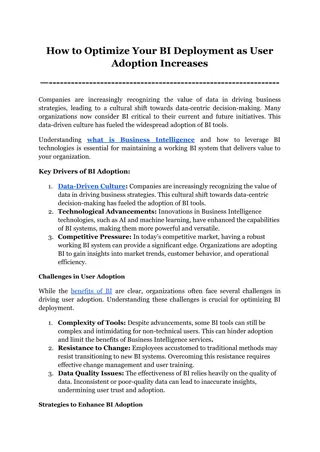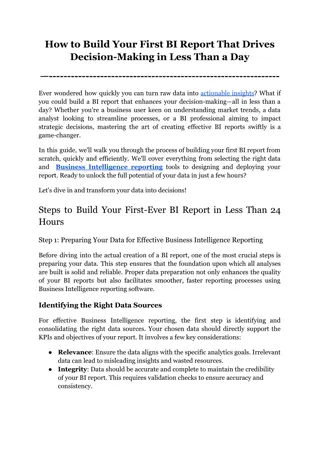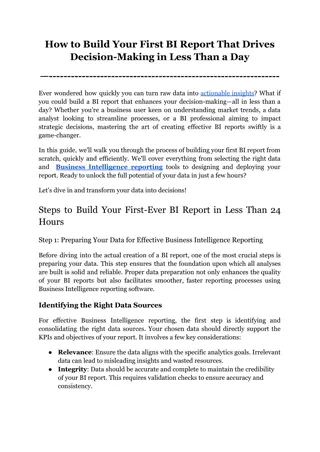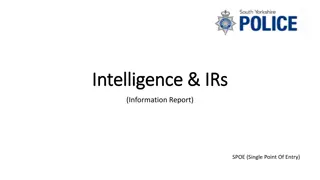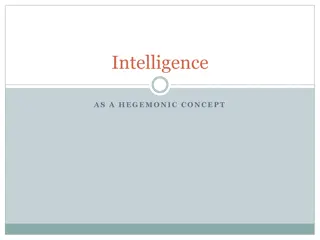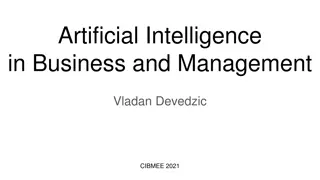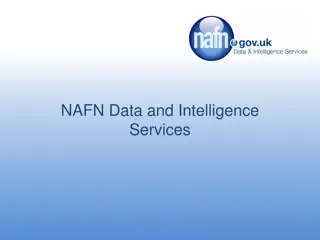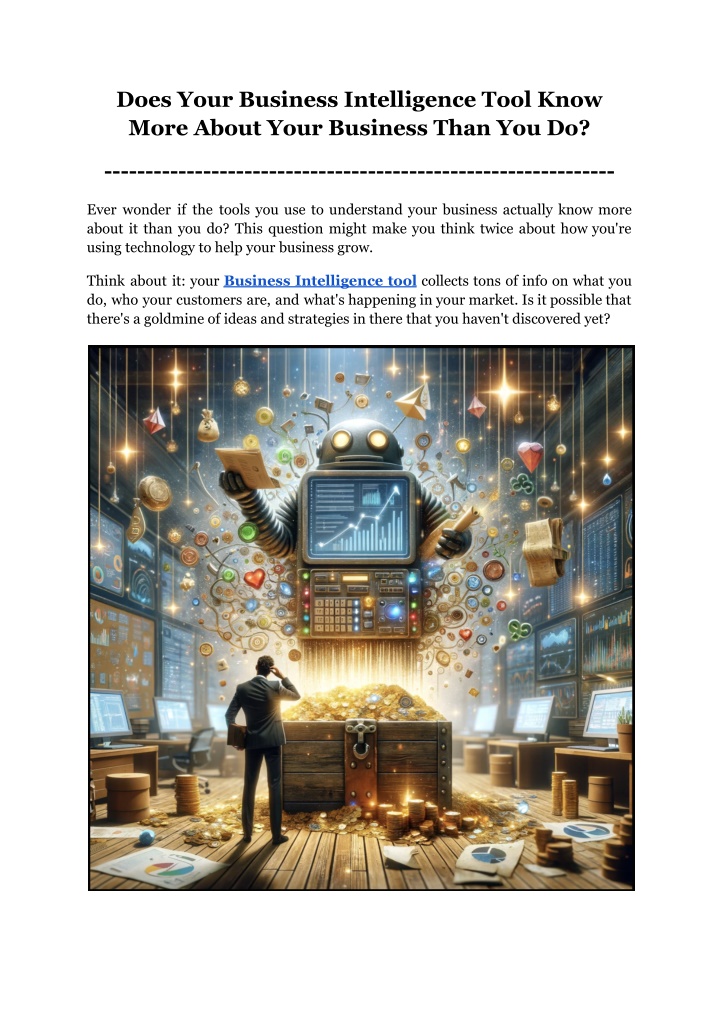
Does Your Business Intelligence Tool Know More About Your Business Than You Do_
Explore the untapped potential of Business Intelligence tools in our latest blog. Discover how to leverage data insights for strategic decisions and unlock the full potential of your business with the right Business Intelligence tool . Dive into practical tips for getting more from your BI tools today.
Download Presentation

Please find below an Image/Link to download the presentation.
The content on the website is provided AS IS for your information and personal use only. It may not be sold, licensed, or shared on other websites without obtaining consent from the author. If you encounter any issues during the download, it is possible that the publisher has removed the file from their server.
You are allowed to download the files provided on this website for personal or commercial use, subject to the condition that they are used lawfully. All files are the property of their respective owners.
The content on the website is provided AS IS for your information and personal use only. It may not be sold, licensed, or shared on other websites without obtaining consent from the author.
E N D
Presentation Transcript
Does Your Business Intelligence Tool Know More About Your Business Than You Do? -------------------------------------------------------------- Ever wonder if the tools you use to understand your business actually know more about it than you do? This question might make you think twice about how you're using technology to help your business grow. Think about it: your Business Intelligence tool collects tons of info on what you do, who your customers are, and what's happening in your market. Is it possible that there's a goldmine of ideas and strategies in there that you haven't discovered yet?
Let's dive into this together and see if we can uncover some hidden gems in your BI tool. Ready to find out what your business could achieve with a little more insight? Also, read: How To Get The Most Out Of Your BI Tools Beyond Basic Reporting: The Multifaceted Capabilities of BI Tools The inception of Business Intelligence tools marked a revolution in data analysis and reporting. However, the journey didn't stop there. Today's best Business Intelligence tools are equipped with functionalities that transcend simple data visualization and reporting. They are designed to be dynamic, interactive, and predictive engines that can guide strategic business decisions. But what makes these tools stand out, and how can businesses ensure they're utilizing these features to their fullest extent? 1. Predictive Analytics and AI Integration: Modern Business Intelligence tools are embedded with AI and machine learning capabilities, enabling them to not just report on historical data, but to predict future trends. For instance, a retail business can use these tools to forecast customer buying patterns, helping in stock optimization and personalized marketing strategies. 2. Automated Insights: Automation in BI tools can significantly reduce the manual effort involved in data analysis. These tools can automatically highlight significant trends, anomalies, and patterns in the data, which might go unnoticed in manual analysis. This feature is particularly valuable in monitoring real-time data streams for quick decision-making. 3. Customization and Flexibility: The best Business Intelligence tools offer extensive customization options, allowing businesses to tailor their analytics and reporting to their specific needs. This flexibility ensures that businesses can focus on the metrics that matter most to them, enhancing operational efficiency and strategic focus. 4. Integration Capabilities: A powerful feature of advanced BI tools is their ability to integrate with various data sources and other business systems. This integration facilitates a holistic view of the business, breaking down silos and providing a unified dashboard of cross-departmental insights. The Data Doesn't Lie One of the most compelling aspects of Business Intelligence tools is their ability to reveal patterns, trends, and anomalies that might not be immediately apparent to human observers. This capability stems from their comprehensive data collection and analysis, which encompasses a wide array of data sources, from internal transactional data to external market trends and social media sentiment.
Business Intelligence reporting tools excel in identifying correlations and patterns within this data, often preconceived notions or expectations. For example, a BI tool might analyze sales data alongside weather patterns, revealing that certain products sell better under specific weather conditions, an insight that could significantly impact inventory and marketing strategies. Furthermore, the anomaly detection capabilities of BI tools are invaluable for operational efficiency and risk management. By monitoring data in real-time, these tools can flag unusual activity, such as a sudden drop in production quality or an uncharacteristic spike in transaction volumes, enabling businesses to address issues proactively before they escalate. uncovering insights that challenge Human Insight vs. Machine Analysis The Scope of Machine Intelligence Business Intelligence tools are engineered to process and analyze data on a scale and at a speed that is simply unattainable by human capabilities. This immense processing power allows BI tools to digest vast datasets, identify trends, perform complex calculations, and predict future patterns in a fraction of the time it would take a human analyst. The capacity of these tools to handle big data is particularly significant in today's data-driven environment. For instance, a BI tool can analyze millions of transactions across different geographies and time zones to detect patterns that could indicate fraud, market shifts, or customer behavior trends. Such analysis, when done manually, would not only be time-consuming but could also be prone to errors.
Moreover, machine analysis, through predictive analytics and machine learning algorithms, can forecast future trends based on historical data. These forecasts can range from consumer demand and inventory levels to financial market movements, providing businesses with a strategic advantage by preparing them for future scenarios before they unfold. The Value of Human Judgment While the analytical prowess of BI tools is undeniable, it is the human element that brings depth and nuance to data interpretation. Human judgment, with its basis in intuition, experience, and contextual understanding, plays a critical role in interpreting the insights provided by BI tools. Humans possess the unique ability to consider external factors that may not be present in the data, such as socio-political events, economic shifts, or even
psychological interpretation ensures that the insights derived from Business Intelligence reporting tools are grounded in reality and are actionable. aspects of consumer behavior. This capacity for contextual Furthermore, human judgment is essential in the ethical considerations of data use. As BI tools become more sophisticated, the potential for misuse of data or biased interpretations increases. It requires human oversight to ensure that data analytics are conducted responsibly, respecting privacy and avoiding discriminatory practices. Synergy for Optimal Decision-Making The optimal use of Business Intelligence tools lies in the synergy between machine intelligence and human judgment. While BI tools can sift through data at an unprecedented scale, providing insights and identifying trends, it is the human touch that contextualizes these insights, making strategic decisions that align with the organization's values and objectives. For businesses to fully harness the capabilities of the best Business Intelligence tools, fostering a culture where data analysts and business professionals work closely with BI tools is essential. Training and developing skills to interpret machine-generated insights critically and apply human judgment effectively can lead to more nuanced and strategic decision-making. Bridging the Gap Between Tool Intelligence and Business Wisdom Leveraging BI for Strategic Advantage The real power of Business Intelligence tools lies not in the data they generate but in the actions that businesses take as a result of that data. To transition from passively receiving insights to actively seeking them out, businesses need to cultivate a culture of curiosity and continuous improvement. Active Data Exploration: Encourage teams to go beyond surface-level insights by digging deeper into the data. This involves asking probing questions, running 'what-if' scenarios, and challenging assumptions. By actively engaging with BI tools, businesses can uncover underlying causes, predict future trends, and identify opportunities for innovation. Custom Analytics Models: Develop custom analytics models tailored to specific business questions or challenges. The best Business Intelligence tools offer flexibility to adapt to unique business environments, enabling organizations to focus on metrics that matter most to their strategic goals. Data Literacy Programs: Invest in data literacy across the organization to empower employees with the knowledge to interpret BI outputs accurately.
Understanding data not only at a technical level but in a business context ensures that insights lead to actionable strategies. Integrating BI Insights with Business Acumen The integration of BI insights with business acumen is pivotal in translating data into meaningful business strategies. This requires a deliberate effort to align the analytical capabilities of BI tools with the nuanced understanding of the business landscape that human leaders possess. Strategic Alignment Workshops: Conduct workshops where data analysts and business leaders collaborate to align BI insights with business goals. These sessions can help in mapping out how data insights support strategic objectives, ensuring that data-driven decisions are in sync with the company s vision and mission. Scenario Planning: Utilize BI tools for scenario planning, leveraging their predictive analytics capabilities to forecast various business conditions. When combined with the experience and intuition of business leaders, scenario planning can prepare organizations for multiple futures, making them more agile and resilient. Feedback Loops: Establish feedback loops where insights derived from Business Intelligence reporting tools are continuously evaluated against business outcomes. This iterative process allows businesses to refine their strategies based on real-world performance, ensuring that BI tools are tuned to deliver the most relevant and impactful insights. Cross-functional Data Teams: Create cross-functional teams that include data analysts, business strategists, and operational leaders. This integration ensures that insights from BI tools are interpreted within the broader context of the business, fostering a holistic approach to data-driven decision-making. Conclusion While going over the above content, it becomes clear that the true power lies in the collaboration between the smart analytics of BI tools and your own expert insights. It's all about bringing together the best of both worlds - the cutting-edge analytics that BI tools offer and the invaluable judgment and intuition that you and your team possess. With Grow's Business Intelligence tool, this partnership reaches new heights, offering an easy-to-use platform that merges complex data analytics with your strategic business knowledge. Imagine having the ability to tap into deep insights and align them perfectly with your business goals, all within a tool that's designed with your needs in mind.
Why not see for yourself? You're invited to dive in with Grow's 14-day free trial. It's a chance to explore how Grow can sharpen your decision-making and bring hidden insights to light. Discover firsthand the difference it can make in navigating your business landscape. And don't just take our word for it. Check out "Grow Reviews from Verified Users on Capterra" to see stories from businesses just like yours. The aim isn't to compete with your Business Intelligence tool for insights into your business but to join forces, enhancing your strategic vision with solid data backing. By teaming up with Grow, you're setting the stage for success, leveraging both your business savvy and Grow's analytical prowess.

